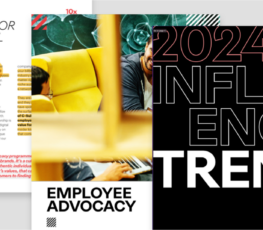One initiative that many companies have focused on in recent years is getting employees to join social conversations and share content to their networks.
Typically, this is enhanced with an employee advocacy strategy and program, which makes it much easier to see an impact on sales, marketing, communications, and employee engagement.
Whether you utilize an employee advocacy program or not, a common barrier is employees just do not seem to be sharing content often or at all. What gives?
There are quite a few reasons why employees might not be sharing content or interested in doing so. Some of those reasons might be obvious and others might not have come to mind. Either way, your company will need to adjust a few things and you should start seeing employees more engaged and consistently sharing.
Your company culture is bad
Typically, the first aspect you need to evaluate is your company’s work culture because if there are some internal issues, employees will not go above and beyond for you.
Does your company get a lot of bad press? Is your company treating employees as just a number to boost company profits? Are your company leaders not transparent about the business? Do your employees believe in the brand, goals, and mission of the business?
If you are not cultivating a good company culture, employees only see your company as a paycheck. They go to work, get the tasks complete, and leave. You want employees to be excited to come to work, feel pride in the brand they represent, and go the extra mile without asking.
Before you can get employees interested in sharing content, you’ll need to ensure your company culture is solid. If not, it’s time to evaluate and make changes as it is probably affecting more than you realize.
The content is just not that interesting
Employees want to share content that is not only interesting and unique, but that does not just seem like company spam.
Many companies run into a content marketing problem where everything they create is just about themselves, about their new product or services, or about their press. Of course, this content is important to have, but your company needs content that focuses on the buyer’s journey too.
Additionally, the content also should be a mix of videos, infographics, and other various medium forms, otherwise, the content arsenal grows stale and lacks appeal.
Your company should also encourage third-party content related to whatever industry you’re in. This shows your company is a knowledge hub and employees will appreciate the mix of content sources.
Employees aren’t aware of your company’s social policy
Before allowing employees to participate in social media or encouraging colleagues to get online, your company needs to have a social media policy in place. As of the 21st century, most companies will have some sort of policy in place for social media.
Yet, how many of the workforce actually are aware of it, know the guidelines, or even know where to find it?
For large companies, this can be a challenge and another reason why employees are not sharing content or sharing more often. But in general, if employees are not aware of the social policies or afraid they are going to do the wrong thing online, they will avoid getting involved.
If your company has a social media policy, it needs to be simple, easy to understand, accessible, clearly defined, and needs to be shared with employees directly. If your company does not have one, it is important one is created before encouraging employees to be advocates on social.
Need some sample social media policies? Let’s take a look at a few well-known brands policies.
Your social policy has too many rules and regulations
While needing a social media policy and making sure it is easily accessible is important, there is a second part to this that can deter employees from content sharing.
Simply put, having too many rules or regulations in your policy can also hinder results.
Imagine getting a mini booklet for a social media policy with hundreds of bullet points saying what is and isn’t acceptable. A few things might happen: Employees will ignore it completely, read it and avoid getting involved or be frustrated with having to keep track of everything.
Employees already have enough on their plate with their expected job tasks and giving them something overly complicated with a lot of rules is not going to be exciting. You want employees to be interested in sharing on social media, not feeling like their job just got more complicated.
Your corporate newsletter to employees sucks
Having employees interested in company content and sharing to their networks is not necessarily a new concept, but to have it work accurately has been a consistently growing challenge.
One solution that many companies have implemented is an internal corporate newsletter with some share buttons added. Yet this generally seems to yield very little results.
To put it bluntly, your corporate newsletter sucks. Slapping some company content into a designed email, sent to employees, and hoping for engagement is just not going to cut it.
Often the reason corporate internal newsletters do not work are:
- A limited amount of content added to it
- Content is all about the company
- Content is too “sales” sounding
- Employees have no contribution
- Emails get buried or forgotten when it is not related to their actual work
- No value to the employees to share
Now, this is not to say an internal newsletter should not be sent out, but it should not be havily relied on for social media participation by employees. It just doesn’t yield the best results.
No social tool to make content sharing easy
This is why employee advocacy and social selling platforms have become a necessity for getting employees involved in social media. Large brands all over have been adopting the strategy and software tools to make it easier.
A software tool like EveryoneSocial for example, creates one central location for all employees to access third-party content, company content, different streams of content created by their admins, the personal content of their choosing, and have their socials can be connected.
Employees can spend a few minutes each day, posting or scheduling ahead of time, amplifying their personal brands and helping their company grow. Additionally, included is gamification and leaderboards to encourage participation and incentivizing the process.
Plus, you can still send a newsletter of top content as an additional reminder. Employee advocacy tools are a better solution and allow employees to have a personal experience, which is what is missing from a plain weekly or monthly newsletter.
But you also need a tool that is intuitive and easy to learn, otherwise, employees will get frustrated and quickly abandon using it.
Leadership not setting an example
Pending on the size of your company and divisions of departments, which level of leadership that gets involved in social may vary.
Regardless, if managers and executives are not sharing content, pro-actively caring about social, or promoting a social culture, then employees also do not have a reason to care either.
Your company’s leaders are looked at for guidance and should be building a great culture, without that employees will feel more disconnected from their company. This also applies to any initiative within the company, like content sharing on social media.
When leaders and managers are also sharing, showing enthusiasm, and voicing their interest in social media, more employees are inclined to follow and value it just as much.
Now, not all C-Suite level leaders may be able to always be proactive, but it can go a long way it getting more support of the workforce. For example, T-Mobile’s CEO John Legere is quite active on social and is great for employees to see how active he is and shows he values being a social business.
Employees aren’t clear why sharing on social matters
By now, a vast majority of your employees are aware of social media and the big name platforms like Facebook, Twitter, and Linkedin. But how aware is your workforce to why social media is important for them to get involved and sharing company content?
The concept of getting employees active on social media and the role it can play in growing your business is still a somewhat new concept. Of course, marketing and probably a good portion of sales folks understand the value, but others may see it as not part of their job.
Yet, sharing brand content, third-party, and personal interests creates a positive human touch, develops thought leadership, and shows employees knowledge and passion for their work.
For years when social media started exploding, many companies saw it as time-wasters, not adding much value, and would block sites from workers computers. Yet, most companies have shifted that mindset and realize how important it is to their business.
A big portion of why employees are not getting involved is they are unaware of the positive impact it can have on their career status and how it actually benefits the growth of their company. This understanding can change and needs to come from corporate leaders and management, who can educate their teams further.
Examples of educating employees:
- Have training sessions or workshops that employees can attend
- Have a clear mission and social media guidelines posted
- Educate new hires on the social media beliefs and values
- Provide content that provides info on employees being active on social
Everyone at your company has a different view and knowledge of social media, but it’s up to your company to get everyone generally on the same page. Plus, without an understanding of the benefits, employees are not going to show any interest in getting involved.
Final Thoughts
Getting your workforce to be active on social media can be a bit challenging at first, but if you put a unique employee advocacy strategy and platform in place, your company can see a unique social army develop.
Yet, it also takes more than a strategy and platform, as there are still other reasons employees, might not get involved. Certainly, there will be employees who might not get involved at all regardless, but the above eight reasons are why many are not active online currently.
If you recognize those above challenges and make some adjustments, you’ll find more employees getting involved in social sharing and getting your brand in front of more prospects and potential buyers.
Learn how popular video game publisher Electronic Arts unified over 10,000 employees on social media through employee advocacy. Get your resource.
















